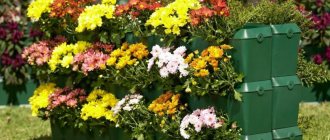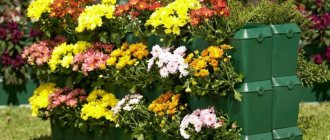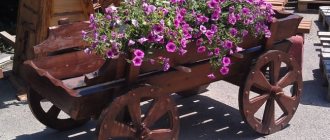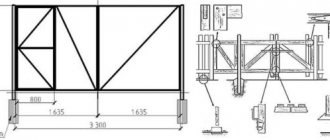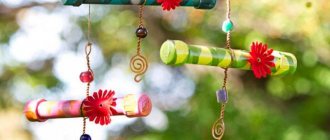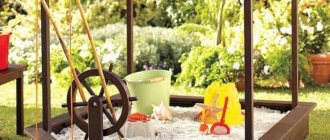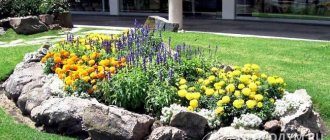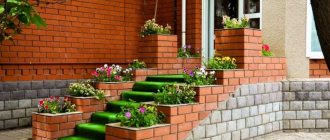Review author: Terrari School of Design
Amateur summer residents often do not know how to beautifully decorate their garden plot.
There are a wide variety of options for decorating a site. One of these is the popular type of landscape design - flower bed.
Decorative flower beds (photo) look organic and very beautiful in personal plots; they also help to disguise unsightly areas on the territory. Almost everyone without exception likes delicate floral scents; they lift the mood and pleasantly please the eye.
Flowerbeds are given an original shape mainly so that they attract attention, being the visual center of the flower arrangement.
With the help of a flower bed, you can easily and simply eliminate all the protruding unevenness in the landscape with your own hands. The right design technique will allow you to design the territory in both horizontal and vertical formats. If the land for planting is not very good, unpretentious plants can be planted in flower beds.
Creating a flowerbed with your own hands will help to beautifully decorate the area around the country house, but only if the designers and the owners themselves have a clear idea of what they will do and how correctly everything can be decorated.
Material for flowerbed design
Before creating a flower bed, it is important to select the material to create its border. Properly selected decorative fences will make the garden more interesting and easier to care for. Due to the fencing, grass does not grow into flower beds, and soil does not fall onto lawns and paths.
Decorative fences can protect flowers from trampling and visually separate them from paths and lawns. In order for a decorative fence to become a good protection against unnecessary grass, it must be made in the ground at a depth of about 25 cm.
There are a lot of different materials for decorating fencing. In specialized stores you can purchase ready-made finishing options, such as:
- plastic strips, strips, and barriers
- concrete palisades
- wooden pegs
You can also adapt natural materials (stones, tree debris, branches) or give a second life to things that have gone out of use (pallets, old bricks).
Flower beds with wide edges look very impressive. They can be made using large stones, bricks, sleepers, and concrete slabs. You can create a fence from crushed stone or gravel.
To ensure that the edge remains invisible, thin strips of plastic or metal are made; they are simply hidden under a layer of garden bark and litter. The edges of the flower garden are decorated with flowers of low-growing varieties.
By separating the flowerbed, you can make fences from unnecessary used things:
- glass bottles
- cans
- bricks
- roof tiles
- car tires
What plants can be planted in a flower garden?
In early spring, small bulbous plants begin to bloom. This group of plants for a perennial flower garden includes: daffodils, chionodoxes, muscari, poultry plants, crocuses. They do not need to be dug up annually for storage, like tulips or gladioli.
The bulbs are planted at a distance of 10 cm from each other in large quantities. This is necessary in order to form a beautiful island of identical flowers, since most small-bulbous plants are short-growing (up to 20 cm). Their leaves are narrow and long, and their decorative effect is achieved solely through inflorescences, like those of muscari or hyacinth. Single specimens of such colors will be inconspicuous.
A little later, the familiar daisies and primroses, violets and dream grass begin to bloom. These are also quite small and inconspicuous individual primroses. To create a flower garden of continuous flowering, you will need a lot of planting material of primroses of any kind. But the decorativeness of the island of land that has barely appeared from under the snow is worth the expense of money and labor.
Flowers for summer and autumn
Perennials that bloom in warm weather are rich in both color and number of species. Beginning in May, peonies and irises bloom in a variety of colors. Later they are joined by daylilies and garden lilies, creating bright splashes of yellow, orange and red. Astilbe panicles harmoniously resonate with tall cereals: pampas grass, reed grass, pike grass. By placing tall candles of delphiniums in the background of the composition, you can support them with lupines of different heights and colors in the middle and foreground.
Ground cover plants like periwinkle, thyme, tenacious and others are also blooming. Despite the inconspicuousness of individual flowers, their clusters among grasses create picturesque spots of different colors. You can also supplement the compositions with wild herbs - yarrow and tansy with large inflorescences, jasmine, green grass, sage. These herbs are able to bloom throughout the season, filling the gaps between individual varieties and types of garden flowers.
At the end of summer, more and more yellow shades appear: rudbeckias, herbaceous sunflowers, yellow lilies and chrysanthemums. These colors can be harmoniously diluted by selecting varieties of red chrysanthemums and late dark pink phlox. The violet-blue range of September flowers and cushion asters will help to form flower beds in appropriate shades. By removing old flower stalks on astilbes and delphiniums, you can force these plants to bloom again.
Careful care of a perennial flower garden will help you enjoy the changing seasons and colors for several years in a row without annual work. Planted once, ornamental shrubs and flowers will delight the owners for a long time.
Fencing made of large stones, boulders, concrete
Large natural stones are often used to decorate rocky gardens and flower beds. Large boulders look incredibly beautiful when enclosing a flower bed with tall flowers. Flowerbeds made of stones are easy to make yourself; they look very colorful.
The strongest and most resistant stone and concrete fences, they will last much longer than wood or plastic. They have excellent wear resistance and do not require constant maintenance. Concrete is a fairly durable material, excellent for creating edging in the form of low walls, strips that are flush with the ground.
How to build a rock garden?
An alpine slide or rock garden is an independent decorative element in the garden. Most often they decorate green lawns in the form of a beautiful pile of stones overgrown with evergreens of contrasting shapes.
Experts have developed many techniques for constructing this type of garden decor so that the rock garden becomes a real “eye candy.” They are made in different places:
- at the country gate;
- at the front door;
- opposite the windows;
- on the grill and barbecue area;
- in public recreation areas.
It is important to choose the right place, preferably in the middle of a green lawn or near a decorative pond. There must be enough nutrients in the soil, heat and light, otherwise the plants will gradually turn yellow, wither and degrade
Excess moisture, as well as lack of watering, will be detrimental to particularly sensitive plants.
If you do not take into account the complex technique of multi-layer soil reinforcement on slopes and cascades, then the rock garden itself is not difficult to make.
If you look at several photos of a decorative flower bed like an alpine slide, you will notice that the stones are not laid chaotically, it is a multi-level cascade of stones. A massive cobblestone lies at the base, then medium-sized stones and after planting the roots are strengthened with pebbles or fine crushed stone.
A prerequisite is a lower “cushion” of gravel and sand to organize proper drainage. The soil for plants should be nutritious; it would not hurt to fertilize it for the winter. It is poured between cobblestones to plant plants and fast-growing grass for the flower bed.
Decorative fencing made of wooden pegs
For a summer cottage, a great idea would be to decorate a flower bed using wooden pegs. In summer cottages you can often find broken branches of trees, which are suitable for blocks with which you can make a flower garden fence.
Wicker fence
A decorative wicker fence, woven with your own hands, will add originality to the garden and help save money - a fence created by yourself costs absolutely nothing.
It is best to weave a fence from a vine, but you can use other flexible branches left after cutting down trees and bushes. Birch decorative barriers look very expressive. The height of the wicker fence should be approximately 0.4-0.6 meters.
The base of the fence is made from long, thick branches of willow or grapevine. First of all, pegs are placed around the perimeter - in the corners and along the walls. A frame is woven between the pegs to create a fairly dense fence. Very long branches are trimmed. Secure the walls with corner clamps.
Wicker fences for flower beds are ideal for naturalistic and rustic gardens, perfect for decorative flower beds of roses, tall plants, and ornamental grasses.
Fashionable and original solutions for designing flower beds
Ordinary pots and flower beds can be revived and transformed with the help of unusual ideas. Decorative flower beds can be made from all kinds of available materials. For this you will need:
- tires
- old stumps,
- tree trunks
- old furniture
- old buckets and watering cans
- plastic bottles.
Shoes can become very fun flower pots; you just need to fill them with soil and plant flowers.
Spilled flowers
The popular design trend “spill flowers” has come to us. The flowers seemed to spill out of an overturned vessel. This design looks incredibly beautiful. This wonderful idea will decorate any garden. This could be a flat area, an area near a pond, or an alpine hill.
In the latter option, you can create a beautiful composition when a stream of flowers cascades down like a waterfall. You can use absolutely any vessel as a container. This can be not only an ordinary flower pot, but also a milk can or an old bucket.
The color palette is also varied and depends on the main landscape. White, yellow, pink flowers will look great on a lush bright green carpet. If the substrate is soil, gravel, or tree bark, you can choose options with darker colors: blue, purple, bright orange, burgundy.
What is important here is not the type of container, but the well-chosen flowers that “pouring” from it. Of course, these should be dense, low-growing plants for a flower bed. But a combination of simple low flowers also looks good: marigolds, petunias, primroses, pansies.
Where to begin?
Where to start creating an unusual homemade flower bed? The first step is to clear out the old junk in your shed or garage. Then you need to think over the design of the flower bed and choose a place for its location. To do this, carefully examine the area and choose a piece of land that is clearly visible. It should also be relatively well lit.
On a note! It is best to place flower beds (and especially unusual ones) where they will be clearly visible from the house or porch, as well as from the street, if you want to please people passing by with their beauty.
Do-it-yourself log flowerbed
When you create a flowerbed project, be sure to draw the shape of the flower bed on paper, and also mark where and what flowers should be. Consider their flowering time, growth rate, petal color, height and much more. If you are forming compositions from perennials, then you should select plants with special care - if annuals are easy to replace with others next year, then perennial crops will grow in your flowerbed for several years.
Sketch of the future flower garden
3 design options for a cereal flower bed
Scheme of a round flower bed of continuous flowering
Scheme of a flower bed of perennials
Those items from which it is planned to create a flower garden should, if necessary, be washed, provided with drainage holes, painted, and unnecessary parts removed. If this is some kind of container, then expanded clay must be poured onto the bottom as a drainage material so that excess moisture does not accumulate in the soil itself.
Vertical flower bed from a pallet
In small gardens and loggias there is not much space, so you need to carefully plan the surface and choose the best solutions that will help you place more details while taking up less space. A vertical flower bed will allow you to plant many plants in a small area.
Old tires can be used to create raised beds - you just need to connect a few tires together. Old car tires filled with soil and flowers are probably the most common type of flower bed in dachas. Tires can be painted in bright colors, applied with an ornament or an interesting pattern, and hung on the wall.
Almost any of the presented materials can be used in several ways. The only limitation is the imagination of the owners of personal plots. It is important not to “overdo it” in such ingenuity and preserve the main task of the fence (fencing): to limit the surface of the flowerbed.
It often happens that for the sake of beauty, practicality is neglected and the decorative fence quickly becomes unusable. Therefore, it is better to use reliable, time-tested methods. A rim with uneven edges can create a risk of injury; unstable materials will quickly fail.
The result will be additional, unnecessary work, wasted time. Still, creating a flower bed is not like building a house, and anyone who has the desire can do it with their own hands, using these simple tips.
Types and names of objects
In landscape design, a flowerbed is a small (usually) mound of earth with clear boundaries. From the items listed above you can make not only such flower beds. We’ll tell you in more detail how to decorate a flower garden with your own hands in different shapes.
Rabatka
A long rectangular bed with flowers of one, two, three types. It is arranged along a path or fence. Depending on the number of borders, it can be one-sided or two-sided. Such a landscape object is usually created in city parks.
Instagram @architectures_idea
Instagram @makowepole_
- Landscape
6 unpretentious perennial flowers for decorating borders on the site (beautiful and simple!)
Front garden
A small plot located in front of the house, near the road. Usually it is fenced with decorative hedges, which can be quite high. The front garden is suitable for decorating flower beds with perennial flowers.
Instagram @bloomscottagegarden
Instagram @comfort_home_krd
Mixborder
Mixborders can have any shape, size and location. Plants that bloom at different times are selected for it. Such a flower garden pleases with its beauty for a long period: from spring to autumn.
Instagram @natalia_sorriso_d_oro
Instagram @karolliudmila
- Landscape
8 ways to decorate your garden in the fall, when everything has withered and fallen
Arabesque
Plants are planted in a certain order, forming a pattern or ornament. Seedlings must be selected very carefully so that they all bloom at the same time.
Instagram @masterbordur_
Instagram @innacugaevskaja
Alpine slide
This is a composition imitating a mountain landscape. There is a stone in its center, and the slopes are made in the form of terraces on which unpretentious, low-growing flowers or ground covers are planted.
Instagram @tierraverde.prof
Instagram @gulinsad
- Landscape
How to make an alpine slide at your dacha with your own hands
